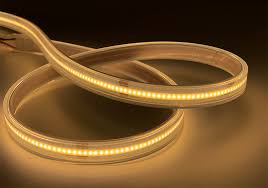LED strip lights wholesale can be put to use in all manners of extreme conditions provided that they are designed/ rated for their environment. Whether or not an LED strip light will survive rough weather comes down to a number of things, such as its IP rating and build quality but most crucially the temperature it can go through.
The weatherproof nature of the LED strip lights is determined by IP (Ingress Protection) ratings. The strip is suitable for outdoor use in low-pressure water and moderate weather conditions due to its IP65 rating. For more severe applications, IP67 strips protect against temporary immersion in water, and IP68 strip can survive continuous submersion as well high-pressure water jets. LED strip lights are given water ratings to indicate how well they will hold up in heavy rain or snow.
Another factor to keep in consideration is the temperature tolerance. The operating temperature range- High-quality of LED strip lights can operate in a broad temperature area which is typically from -20–60°C(-4°F to 140°F). It is up to 90% for all possible extreme weather cases: summers or winters. For example, the same LED strip used in Alaska versus Arizona must withstand different temperatures. The purpose of the layers is to keep up with these rated temperatures so that their performance and life are not reduced.
LED strip lights are also made with different materials, which will determine how well they respond to extreme changes in weather. Silicone or epoxy coatings are also used to protect from moisture (if the device is placed in uncontrolled outdoor conditions), solar ultraviolet radiation, physical impact etc. These materials protects the LEDs and circuitry from environmental influences. One such example includes strips with strong coatings to protect against corrosion in salty coastal zones.

LED strip lights are run through tests in extreme or simulated conditions to ensure their reliability. Manufacturers generally subject their products to hard tests - thermal cycling and moisture resistance, for example -- in order that they will not fail when the going gets tough. LEDs in particular can maintain 70% of their original light output even once extreme temperatures have taken a toll, according to one U.S. Department of Energy report - showing that this method is built for the long haul.
For example, LED strip lights have shown to be resilient enough for some of the most punishing environments known - our urban infrastructure. The LED strips found in them also need to manage the climate variety of New York City, from snowstorms to summer heatwaves. Typically, they will use high-IP-rated LED strips which can tolerate the temperature extremes to ensure that their signs are always working and look as good at night.
Durability for extreme conditions remain a top benefit of LED strip lights and energy efficiency. They are extremely energy efficient - up to 75% less than traditional lighting, making them a great solution for off grid and remote areas which any power resources are limited or non-existent. That, together with a lifespan of up to 50,000 hours also leads to less replacement and maintenance which ultimately savesMoney in the End.
For applications in extreme weather, the newly designed LED strip lights can also be equipped with an extra layer of protective features. Both thermal heatsinks and management systems help optimize the performance in hot climates, while anti-freeze technologies ensure that no damage is caused by freezing temperatures. Ensuring that LED strips continue to function in even the most challenging conditions, are customizations such as these.
Cost: High-end LED strip lights that are weatherproof or sealed to avoid exposure, freshness in the color tone and long life time may have relatively minimal upfront cost at start but remarkable return on investment. Less energy usage, less maintenance expense, and a longer life all add up to save money in the long run. According to the Energy Information Administration, efficient LED lighting in commercial buildings saves between 30% of average annual electricity for a light.
Additive Basic LED strip lights for harsh environment, and high IP ratings + robust materials + wide temperature tolerance & advanced protection technologies make great candidates to light up different fields under rough condition. Such features provide strength, dependability and efficiency, which make them suitable for any type of application from relaxing at home to working in the commercial sector with harsh weather.